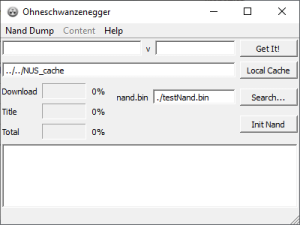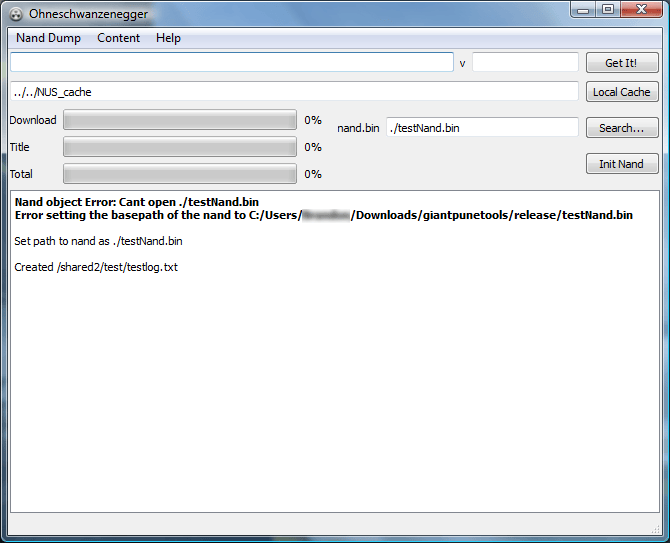More actions
| ohneschwanzenegger | |
|---|---|
 | |
| General | |
| Author | giantpune |
| Type | PC utilities |
| Version | r118 |
| License | Mixed |
| Last Updated | 2022/03/23 |
| Links | |
| Download | |
| Website | |
| Source | |
Ohneschwanzenegger'is a program for creating, formatting, & writing to a nand.bin. It allows you to create a nand.bin on your PC that you can then install with BootMii or a flash programmer.
It accepts system WADs or can download titles and full updates from NUS. It is still recommended that you check the contents of a nand.bin before installing it to a Wii. It can be compiled on Windows, Linux or Mac OS X using Qt.
This was submitted to the GBAtemp Homebrew Bounty 2011 (Wii).
User guide
The download link is for the Windows version. You also need these DLL files.
Here is a Mac OS X version. You will need to install the Qt SDK from here in order to run it.
ReadMii
This is a tool to build a nand.bin suitable for installing on a Nintendo Wii via BootMii. It cannot build one from scratch - you must provide some data from the Wii. It needs to have a copy of the first 8 blocks of nand, a list of bad blocks, and AES & hmac keys. All of this data can be obtained from a BootMii NAND dump, even if it is bricked.
Creating a blank NAND
- Select File > New Nand (ctrl+N).
- select the destination for the new file in the "destination" field. Make sure you have 528MiB of free space.
- If you have an existing nand.bin from the Wii, you can select it by clicking the "Existing Nand" button. This will fill in the rest of the necessary information.
- If you dont have an existing dump to read from, you can enter the path of "keys.bin", the first 8 blocks of nand (including spare data), and the bad blocks using the rest of the dialog window. Bad blocks may be entered manually, or read from a plaintext file with 1 number on each line.
- When you click the "Ok" button, the GUI will hang a bit as it writes the entire 528MiB file to your PC.
Opening an existing NAND
- Enter a path of an existing nand.bin in the "nand.bin" field, or press the "search" button to browse for it on your PC.
- Once you have selected one, click "Init NAND" to tell the program you are ready.
Note: Do not use this program on your only copy of a Nand. Make a copy and use that.
Downloading titles and installing them
- Before you do anything, set a path for the NUS cache. This is where the program will cache downloaded files for later use. This should be a location that has decent reading & writing speeds (dont use an SD card).
- The upper fields accept a TID and/or version to download and install a specific title. Leave the version field empty to get the latest version.
- It also accepts a string such as "3.2u", 4.3e", or "3.5k". This will attempt to get all of the titles that were in the given update. I have used wiimpersonator logs when available, and game update partitions where the wiimpersonator logs were missing. There are some discrepancies as to which titles should be in a given update based on update partitions, but I believe I've gotten it pretty close.
- Press the "get it" button.
- When all the titles are done downloading, it will check for a setting.txt. If there is a system menu, but no setting.txt, it will prompt you to create one.
Creating & editing setting.txt
- Select Content > setting.txt. If there is already one, it will be read from the current NAND. A dialog window will pop up and you can enter values such as region & serial number.
- Clicking "Ok" will have the program try to write the setting.txt to the NAND.
Content > Write meta entries
This will write the garbage in "/meta" on the NAND FS.
These serve no purpose other than to take up space. The wii appears to run perfectly fine without them. If I had to guess, I would say they are created during the initial installation of titles in the factory and simply never deleted.
There are discrepencies as to which entries are in the /meta folder based on which wii you look at. This program will only write the bare minimum ones: the system menu, IOS4, and IOS9. However, I have seen entries for bc, mios, all the 10002 channels, and the stock hidden channels.
Error handling
There is a log window in the gui. Any time there is an error, it should show up bold. Due to the huge size of a NAND, there is no "undo". When a mistake/error/bug happens, there is no turning back. If you see an error dealing with writing to a file, it is recommended that you delete that file and start over.
Note: Do not install anything this program writes without first verifying its contents.
Screenshots

Credits
This tool is made possible by the open-source efforts from others - including, but not limited to:
- bushing
- segher
- comex
- marcan
- trap15
- grey
- parannoyed
- everybody behind the Qt framework
